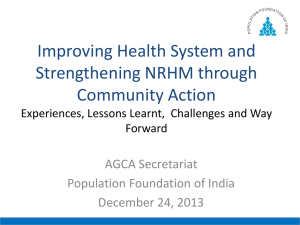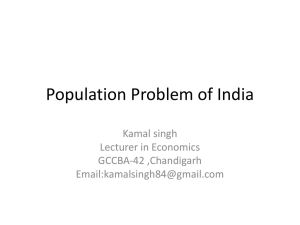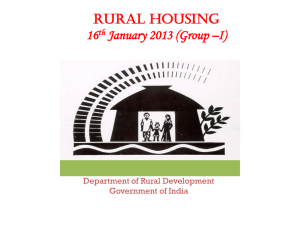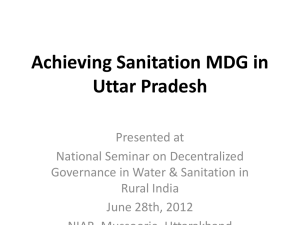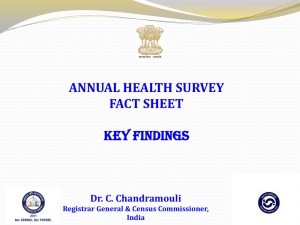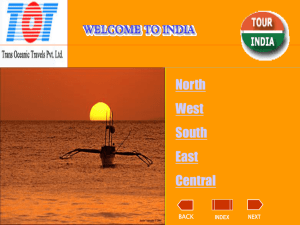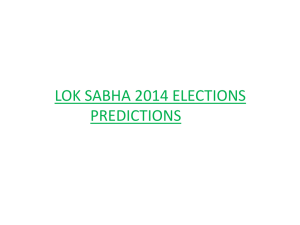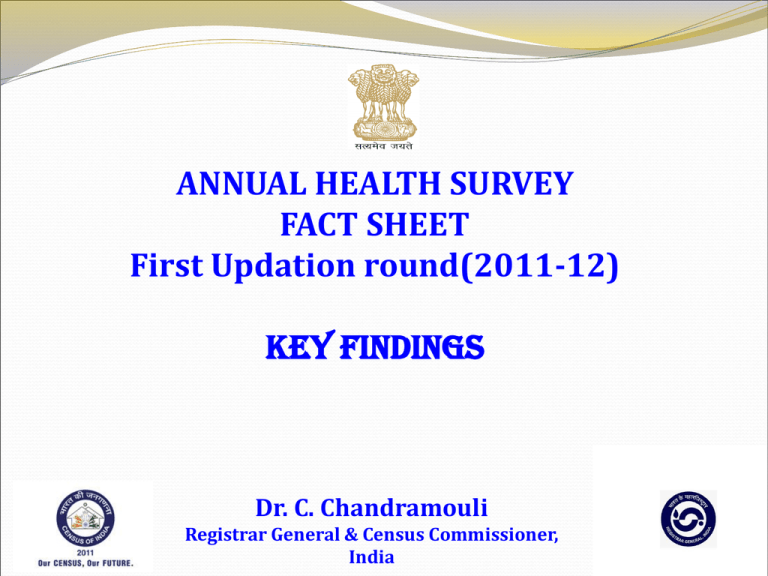
ANNUAL HEALTH SURVEY
FACT SHEET
First Updation round(2011-12)
KEY FINDINGS
Dr. C. Chandramouli
Registrar General & Census Commissioner,
India
“ Reproductive health and rights are integral to
sustainable development and poverty reduction.
Investing in universal access to reproductive health is
crucial investment in healthy societies and a more
sustainable future”.
– Ban Ki-moon, Secretary-General, UN on World
Population Day, 2012
“ Working for the survival and the well being of women and
girls is a human right imperative. And in order to take
advantage of women’s full potential in the development of
their nations, they must be able to plan their lives and
families.”
– Babatunde Osotimehin, Executive Director, UNFPA on World
Population Day, 2012
“ There should be an Annual Health Survey of all
districts which could be published/monitored and
compared against benchmarks”
-Dr. Manmohan Singh, Prime Minister of India – In the meeting
of National Commission of Population, 2005
AHS provides key indicators on Reproductive
and Child Health at District level
in 8 EAG States and
Assam
Vital inputs for evidence based intervention and monitoring
OBJECTIVE OF AHS
AHS yields a comprehensive, representative and
reliable dataset on core vital indicators including
composite ones like IMR, MMR and TFR along with
their co-variates (process and outcome indicators) at
the district level and maps changes therein on an
annual basis.
These benchmarks help in better and holistic
understanding and timely monitoring of various
determinants on well-being and health of population
particularly Reproductive and Child Health.
Coverage : Annual Health Survey
Uttarakhand
Rajasthan
Uttar Pradesh
Assam
Bihar
Madhya Pradesh
Jharkhand
Chhattisgarh
Odisha
Indicators under AHS
• In all, 161 indicators are available from AHS :
Fertility- 13
Sex Ratio- 3
Marriage- 5
Mortality- 7
Mother & Child Care- 63
Ante Natal Care: 11
Post Natal Care: 5
Immunization: 8
Birth Weight: 2
Birth Registration: 2
Awareness in Mothers: 4
Delivery Care: 8
Janani Suraksha Yojana (JSY): 3
Vitamin A & Iron Supplements: 2
Childhood Disease: 6
Breastfeeding & Supplementation: 12
Abortion- 6
Family Planning Practices- 15
Disability- 1
Morbidity- 19
Personal Habits:adults-4 Housing & HH Characteristics- 13
Others- 12
Indicators under AHS
Contd…
Under 1st phase of release, following 9 indicators have already been
released in the Bulletin 2011-12:
Crude Birth Rate (CBR)
Crude Death Rate (CDR)
Infant Mortality Rate (IMR)
Neo-Natal Mortality Rate (NNMR)
Under Five Mortality Rate (U5MR) Maternal Mortality Ratio (MMR)
Sex Ratio at Birth (SRB)
Sex Ratio (0-4 years) and
Sex Ratio (All ages)
Remaining indicators are being released under present phase of
dissemination.
Five Core Themes Covered
• The presentation focuses on results pertaining
to 5 core themes:
Total Fertility Rate
Family Planning: Current Usage & Total Unmet
Need
Ante Natal Care
Delivery & Post Natal Care
Immunization and Breast Feeding Practices
KEY FINDINGS
Improvement has been noticed in most of the
indicators as compared to Baseline.
Replacement level of TFR 2.1 has been achieved in
only 29 out of 284 AHS districts whereas in
Baseline it was 20 districts.
In 145 districts, on an average a woman bears
more than 3 children.
More than half of currently married women aged
15-49 years are not using any method of family
planning in Bihar.
KEY FINDINGS
Female Sterilization continues to remain the
most dominant method of family planning
among the modern methods across all AHS
States except Assam.
At least 12.6% currently married women are yet
to meet their family planning requirement
(Unmet Need) across all AHS States. This was
20.0% in Baseline.
Despite wider penetration of `Any ANC’, the
coverage under ‘first trimester ANC’ as well as
‘3 or more ANCs’ needs further improvement.
KEY FINDINGS
Poor performance of full ANC is primarily due to
low IFA consumption.
Universal coverage of JSY remains a concern
even in better performing States like Odisha, MP
& Rajasthan.
Seven out of every 10 deliveries are ‘safe’ in
Madhya Pradesh, Rajasthan, Odisha and Assam.
KEY FINDINGS
• At least 1 in 7 mothers has not received any PNC
among all the AHS States, in Assam it is 1 in 3
mothers.
• In full immunization, even the better performing
States like Uttarakhand, Chhattisgarh and
Rajasthan fall short by 22-30 percentage points
in achieving universal coverage.
• Percent of traditional method in any method of
family planning is more than 20% in 4 States
namely, Uttar Pradesh, Assam, Jharkhand &
Odisha.
Performance of Hot Spot Districts
55 districts are hotspots (57 in baseline) i.e. common in top 100 districts in
IMR and top 25 Administrative Divisions (111 districts) in MMR.
DISTRICTS FALLING IN
BOTH TOP 100 IMR AND
DISTRICTS OF TOP 25
MMR
Assam- 6
UP - 31
Bihar -1
MP -16
Odisha -1
State wiseTFR of Hot Spot Districts
Uttar Pradesh
7.0
6.0
5.0
4.0
3.0
2.0
1.0
0.0
Madhya Pradesh
4.5
4.0
3.5
3.0
2.5
2.0
1.5
1.0
0.5
0.0
Assam
3.0
2.5
2.0
1.5
1.0
0.5
0.0
State wise Full ANC of Hot Spot Districts
12.0
Uttar Pradesh
10.0
8.0
6.0
4.0
2.0
0.0
Madhya Pradesh
30.0
25.0
20.0
Assam
16.0
14.0
12.0
10.0
15.0
10.0
5.0
8.0
6.0
4.0
2.0
0.0
0.0
State wise Immunization in Hot Spot Districts
Uttar Pradesh
80.0
70.0
60.0
50.0
40.0
30.0
20.0
10.0
0.0
Madhya Pradesh
80.0
70.0
60.0
50.0
Assam
70.0
60.0
50.0
40.0
40.0
30.0
30.0
20.0
20.0
10.0
10.0
0.0
0.0
State wise Institutional Delivery in Hot Spot Districts
80.0
Uttar Pradesh
70.0
60.0
50.0
40.0
30.0
20.0
10.0
0.0
Madhya Pradesh
Assam
70.0
90.0
80.0
70.0
60.0
50.0
40.0
30.0
20.0
10.0
0.0
60.0
50.0
40.0
30.0
20.0
10.0
0.0
TOTAL FERTILITY RATE (TFR)
• TFR is the average number of children born to a woman during her entire
reproductive span.
Total Fertility Rate
4.0
Updation
3.6
Baseline
3.6
3.7
3.4
3.5
3.1
3.0
2.8
2.9
3.1 3.1
3.1
3.2
2.9
2.6
2.5
2.3
2.3 2.3
2.4
2.1
2.0
1.5
1.0
Uttarakhand
Odisha
Assam
Chhattisgarh Jharkhand
Madhya
Pradesh
Rajasthan
Uttar
Pradesh
Bihar
• Uttarakhand & Odisha and UP & Bihar continue to remain two extremes of the
spectrum.
TOTAL FERTILITY RATE (TFR)
Total Fertility Rate
State value
State
District with Minimum TFR
District with Maximum TFR
First
updation
Baseline
First Updation
Assam
2.4
2.6
Kamrup (2.0),
Nalbari (2.0)
Kamrup (2.0),
Nalbari(2.0)
Hailakandi (3.9)
Bihar
3.6
3.7
Patna (2.7)
Patna (2.8)
Chhattisgarh
2.8
2.9
Koriya (2.4),
Kanker (2.4),
Durg (2.4)
Jharkhand
2.9
3.1
Madhya
Pradesh
3.1
Odisha
Range
First
Updation
Baseline
Hailakandi (4.2)
1.9
2.2
Sheohar (4.6)
Sheohar (4.7)
1.9
1.9
Koriya (2.4)
Kawardha (3.7)
Kawardha (3.7)
1.3
1.3
Purbi Singhbhum
(2.2)
Purbi Singhbhum
(2.4)
Pakaur (3.9)
Lohardagga
(4.0)
1.7
1.6
3.1
Bhopal (2.1)
Indore (2.2)
Shivpuri(4.4)
Shivpuri (4.5)
2.3
2.3
2.3
2.3
Anugul (1.9),
Bargarh (1.9),
Jharsuguda (1.9)
Jharsuguda (2.0)
Baudh (3.5)
Boudh (3.7)
1.6
1.7
Rajasthan
3.1
3.2
Kota (2.5)
Kota (2.6)
Barmer (4.5)
Barmer (4.7)
2.0
2.1
Uttar Pradesh
3.4
3.6
Kanpur Nagar (2.2)
Kanpur Nagar (2.3)
Shrawasti (5.8)
Shrawasti (5.9)
3.6
3.6
Uttarakhand
2.1
2.3
Pithoragarh (1.7),
Bageshwar (1.7)
Pithoragarh (1.7)
1.2
1.4
Baseline
First Updation
Haridwar (2.9)
Baseline
Haridwar (3.1)
Within a State, the minimum variability of 1.2 is reported in Uttarakhand and the
maximum of 3.6 in Uttar Pradesh whereas in Baseline it was 1.3 in Chhattisgarh and 3.6
in Uttar Pradesh respectively .
Across 284 districts in 9 AHS States, it ranges from 1.7 in Pithoragarh and Bageshwar
to 5.8 in Shrawasti. In Baseline this varied from 1.7 in Pithoragarh (Uttarakhand) to 5.9
in Shrawasti (UP)- a variability of more than 4 children.
TOTAL FERTILITY RATE (TFR)
Frequency distribution of TFR in terms of No. of Districts in each State
State
0 - 2.1
2.2 - 3.0
3.1 - 4.0
4.1 and above
Grand Total
Assam
7 (3)
14 (16)
2 (3)
0 (1)
23
Bihar
0 (0)
1 (1)
28 (26)
8 (10)
37
Chhattisgarh
0 (0)
14 (12)
2 (4)
0 (0)
16
Jharkhand
0 (0)
9 (8)
9 (10)
0 (0)
18
Madhya Pradesh
1 (0)
19 (15)
22 (25)
3 (5)
45
12 (10)
17 (18)
1 (2)
0 (0)
30
0 (0)
18 (16)
12 (13)
2 (3)
32
0 (0)
14 (9)
45(48)
11 (13)
70
9 (7)
4 (5)
0 (1)
0 (0)
13
29 (20)
110 (100)
121 (132)
24 (32)
284
Odisha
Rajasthan
Uttar Pradesh
Uttarakhand
All States
29 districts have already achieved the replacement
level of 2.1 whereas it was 20 in baseline.
TOTAL FERTILITY RATE (TFR)
Frequency Distribution of change in TFR in Terms of No. Districts in Each State
State
Decreased Decreased Decreased Decreased
by 0.1
by 0.2
by 0.3
by 0.4
Decreased
by 0.5 or
more
Increased Remained Total
Same
Uttarakhand
6
2
2
0
0
0
3
13
Rajasthan
13
14
0
0
0
0
5
32
Uttar Pradesh
25
14
3
7
0
7
14
70
Bihar
16
13
3
0
0
0
5
37
Assam
12
5
2
0
0
0
4
23
Jharkhand
11
5
1
0
0
0
1
18
Odisha
20
4
0
0
0
0
6
30
Chhattisgarh
8
2
0
0
0
0
6
16
Madhya Pradesh
30
9
1
1
0
1
3
45
Total
141
68
12
8
0
8
47
284
TOTAL FERTILITY RATE (TFR)
•229 districts have recorded less TFR than the
baseline estimates and 47 districts remained same.
•8 Districts have recorded increase in TFR viz. Indore
(M.P.), Baghpat, Budaun, Bulandshahar, Gonda,
Lalitpur, Pilibhit and Rampur (U.P.)
•8 Districts have recorded maximum decrease in TFR
viz. Sehore(M.P.),
Basti,
Deoria,
Gorakhpur,
Kaushambi, Kushinagar, Maharajganj, Siddharthnagar
(U.P.)
TOTAL FERTILITY RATE (TFR)
First Updation
Replacement
level of TFR
Baseline
Family Planning: Current Usage
Contraceptive
Prevalence Rate (CPR) is the percentage of
currently married women aged 15-49 yrs who are using any
method of contraception (modern/traditional).
Current Usage- any method (%)
70
Updation
60
Baseline
64.5
66.4
57.9
65.1
61.2
63.4
62.7
61.7
56.2
59.4
49.9
58.6
53.9
47.8
37.6
43.0
30
56.5
40
58.6
50
20
Bihar
Current
Jharkhand
Chhattisgarh Uttar Pradesh
Odisha
Uttarakhand
Madhya
Pradesh
Assam
Rajasthan
usage of any method varies from 43.0 in Bihar to 66.4 in
Rajasthan whereas it was 37.6 in Bihar to 64.5 per cent in
Rajasthan in Baseline.
Family Planning: Current Usage
Any Method of Family Planning (%)
State
State Value
District with Minimum FP
District with Maximum FP
First
Updation
baseline
First
Updation
First
Updation
baseline
Assam
65.1
57.9
Dhubri (45.1)
Dhubri (33.2)
Kamrup (76.0)
Lakhimpur (67.6)
30.9
34.4
Bihar
43.0
37.6
Nawada (31.5)
Siwan (26.0)
Supaul (60.8)
Muzaffarpur (52.2)
29.3
26.2
Jharkhand
56.5
47.8
Gumla (39.0)
Paschimi Singhbhum
(32.7)
Hazaribagh (69.8)
Dhanbad (61.9)
30.8
29.2
Madhya
Pradesh
63.4
61.2
Sidhi (44.6)
Sidhi (45.9)
Damoh (75.7)
Damoh (74.9)
31.1
29.0
Chhattisgarh
58.6
53.9
Dantewada (33.4)
Dantewada (33.4)
Kawardha (68.2)
Dhamtari (68.7)
34.8
35.3
Odisha
59.4
56.2
Baudh (29.8)
Kandhamal (28.6)
Baleshwar (78.1)
Baleshwar (73.4)
48.3
44.8
Rajasthan
66.4
64.5
Jaisalmer (53.3)
Dhaulpur (49.0)
Hanumangarh (89.1)
Ganganagar (79.2)
35.8
30.2
Uttar
Pradesh
58.6
49.9
Sitapur (33.8)
Sitapur (21.9)
Jhansi (74.4)
Jhansi (74.1)
40.6
52.2
Uttarakhand
61.7
62.7
Haridwar (56.2)
Haridwar (53.7)
Pithoragarh (78.2)
Dehradun (67.1)
22.0
13.4
baseline
First
Updation
Range
baseline
Within a State, the least variation is reported in Uttarakhand and the most, in Odisha
whereas in Baseline it was Uttarakhand and Uttar Pradesh respectively.
At district level, current usage of family planning ranges from 29.8 in Baudh (Odisha)
to 89.1 in Hanumangarh (Rajasthan)- a variability of 3 times-whereas in Baseline it
varied from 21.9 in Sitapur (UP) to 79.2 in Ganganagar (Rajasthan) exhibiting a
variability of 4 times.
Family Planning: Current Usage
Frequency distribution of current usage in terms of number of districts in each State
State
0-30
30-50
50-70
70 & above
Total Districts
Assam
0 (0)
2 (3)
15 (20)
6 (0)
23
Bihar
0 (4)
29 (31)
8 (2)
0 (0)
37
Chhattisgarh
0 (0)
3 (7)
13 (9)
0 (0)
16
Jharkhand
0 (0)
7 (13)
11 (5)
0 (0)
18
Madhya Pradesh
0 (0)
1 (2)
40 (40)
4 (3)
45
Odisha
1 (1)
8 (9)
16 (19)
5 (1)
30
Rajasthan
0 (0)
0 (1)
21 (24)
11 (7)
32
Uttar Pradesh
0 (3)
20 (24)
44 (42)
6 (1)
70
Uttarakhand
0 (0)
0 (0)
6 (13)
7 (0)
13
All States
1 (8)
70 (90)
174 (174)
39 (12)
284
As high as 71 districts are reporting less than 50% current usage of any method of
family planning whereas in Baseline it was 98.
39 districts feature in 70% & above category whereas in Baseline it was only 12
districts.
29 out of 37 districts of Bihar have reported less than 50% usage of any method
of family planning. In Baseline it was 35 districts.
Family Planning: Current Usage
First Updation
CURRENT USAGE OF ANY
METHOD OF FAMILY
PLANNING (%)
Dist. with > 60% Usage
Baseline
CURRENT USAGE OF ANY
METHOD OF FAMILY
PLANNING (%)
Family Planning: Current Usage
FEMALE STERILIZATION (%)
Share of sterilization in any modern method of family planning (%)
Assam
Uttar
Pradesh
Jharkhand
Bihar
Odisha
Uttarakhand
Female 35.1 (35.3) 50.4 (55.0) 74.3 (76.3) 81.2 (86.7) 69.7 (68.4) 51.9 (58.7)
Male
0.8 (0.6)
0.5 (0.6)
1.4 (1.2)
0.8 (0.9)
0.4 (0.7)
3.0 (2.8)
Rajasthan
Chhattisgarh
Madhya
Pradesh
77.1 (76.7)
87.4 (92.3)
81.8 (83.6)
0.7 (0.7)
1.8 (2.0)
1.5 (1.7)
Unmet Need for Family Planning
Unmet need of Family Planning broadly means requirement of Family Planning
methods among Currently Married Women but not using any method of Family
Planning .
Unmet Need for Family Planning (%)
45.0
40.0
35.0
33.5
26.4
24.8
29.7
22.6
22.4
21.6
23.2
19.1
23.2
18.1
24.0
15.9
19.6
15.0
12.6
20.0
24.1
30.5
25.0
39.2
30.0
10.0
Rajasthan
Assam
Uttarakhand
Odisha
Madhya
Pradesh
Updation
Jharkhand
Uttar Pradesh Chhattisgarh
Bihar
Baseline
Total unmet need varies from a minimum of 12.6% in Rajasthan to 33.5% in
Bihar. In Baseline it varied from 19.6% in Rajasthan to 39.2% in Bihar.
Unmet need for Family Planning is a crucial indicator for assessing the future
demand for Family Planning services / supplies.
Unmet Need for Family Planning
Total Unmet need (%)
State
State Value
District with Minimum unmet need
District with Maximum unmet need
First Updation
First
Updation
baseline
First Updation
Assam
15.9
24.0
Kamrup (8.4)
Sibsagar (15.3)
Karimganj (33.6)
Bihar
33.5
39.2
Patna (20.2)
Patna (24.6)
Jharkhand
22.6
30.5
Hazaribagh (13.2)
Madhya
Pradesh
21.6
22.4
Chhattisgarh
24.8
Odisha
Range
First
Updation
baseline
Dhubri (42.9)
25.2
27.6
Katihar (46.5)
Kishanganj (52.5)
26.3
27.9
Bokaro (18.2)
Gumla (33.2)
Godda (42.8)
20.0
24.6
Datia(14.4)
Dewas(14.4)
Jabalpur (14.3)
Sidhi(38.3)
Rewa (34.2)
23.9
19.9
26.4
Dhamtari (13.9)
Dhamtari (14.5)
Dantewada (48.7)
Bastar (36.0)
34.8
21.5
19.1
23.2
Kendujhar (9.7)
Baleshwar (6.1)
Baudh (45.3)
Boudh (48.3)
35.6
42.2
Rajasthan
12.6
19.6
Jhunjhunun (3.1)
Ganganagar (10.0)
Jaisalmer (28.1)
Dhaulpur (32.4)
25.0
22.4
Uttar Pradesh
24.1
29.7
Jhansi (12.7)
Mahoba (15.1)
Sultanpur (48.1)
Sitapur (61.3)
35.4
46.2
Uttarakhand
18.1
23.2
Dehradun (12.8)
Dehradun (16.8)
Almora (27.4)
Haridwar (29.2)
14.6
12.4
baseline
baseline
The minimum variability within a State is in Uttarakhand and the maximum in Odisha whereas
in Baseline it was in Uttarakhand and in Uttar Pradesh respectively.
Jhunjhunun (3.1) in Rajasthan and Dantewada (48.7) in Chhattisgarh are the two extremes
across 284 districts. In Baseline it was Baleshwar (6.1) in Odisha and Sitapur (61.3) in Uttar
Pradesh.
Unmet Need for Family Planning
Frequency distribution of unmet need in terms of number of districts in each State
State
0-20
20-40
40-60
60 & above
Total Districts
Assam
16 (6)
7 (16)
0 (1)
0 (0)
23
Bihar
0 (0)
29 (20)
8 (17)
0 (0)
37
Chhattisgarh
3 (4)
12 (12)
1 (0)
0 (0)
16
Jharkhand
5 (2)
13 (13)
0 (3)
0 (0)
18
Madhya Pradesh
12 (18)
33 (27)
0 (0)
0 (0)
45
Odisha
14 (12)
13 (15)
3 (3)
0 (0)
30
Rajasthan
26 (16)
6 (16)
0 (0)
0 (0)
32
23 (9)
42 (52)
5 (8)
0 (1)
70
6 (2)
7 (11)
0 (0)
0 (0)
13
105 (69)
162 (182)
17 (32)
0 (1)
284
Uttar Pradesh
Uttarakhand
All States
In 105 out of 284 districts, the total unmet need for family planning is below
20%. It was 69 in Baseline.
Bihar and Uttar Pradesh continue to dominate in 40% & above category.
Unmet Need for Family Planning
First Updation
TOTAL UNMET NEED FOR
FAMILY PLANNING (%)
Unmet need of <=20
Baseline
TOTAL UNMET NEED FOR
FAMILY PLANNING (%)
Mean Age at Marriage- Female
Mean Age at Marriage is based on the marriages taken place during 2008-2010.
Mean Age at Marriage- Female
25
Updation
Baseline
21.7
22.4
22.0
22.2
21.8
22.0
21.0
21.5
20.9
21.1
20.6
20.9
20.2
20.6
19.7
20.4
19.7
20.1
20
15
Bihar
Rajasthan
Jharkhand
Madhya
Pradesh
Chhattisgarh
Uttar Pradesh
Assam
Uttarakhand
Odisha
Mean age at marriage of females varies from 20.1 in Bihar to 22.4 years in Odisha
whereas in Baseline it was 19.7 in Bihar & Rajasthan to 22.0 years in Uttarakhand.
Marriages among Females below Legal Age (18 yrs)
Based on marriages taken place during 2008-2010.
Marriages among Females below legal age (%)
30
Updation
Baseline
20.2
16.5
21.9
16.3
12.6
12.5
10.4
10.2
8.0
8.9
6.3
6.0
4.7
5.9
4.6
3.0
2.3
10
17.6
20
0
Uttarakhand
Odisha
Chhattisgarh
Uttar
Pradesh
Assam
Madhya
Pradesh
Jharkhand
Rajasthan
Bihar
Varies from 2.3% in Uttarakhand to 16.5% in Bihar whereas in Baseline it was
3.0% in Uttarakhand to 21.9% in Rajasthan.
Marriages among Females below Legal Age (18 yrs)
MARRIAGES AMONG FEMALES
BELOW LEGAL AGE (BELOW 18
YEARS) %
Ante Natal Care (ANC)
Any ANC exceeds 80% in all AHS States.
ANC in 1st trimester: 46.5% in UP & Bihar to 70% in
Chhattisgarh & Madhya Pradesh. In Baseline, this was 40% in UP
& Bihar to 65% in Chhattisgarh & Madhya Pradesh.
Mothers receiving 3 or more ANCs: UP-32.5% to Odisha-78.5%.
This was UP-29.6% to Odisha-76.0 % in Baseline.
Mothers who consumed IFA 100 days or more: 8.1% in UP to
26.0% in Odisha. It was 6.5% in UP to 23.8% in Chhattisgarh in
Baseline.
Low performance in IFA consumption is the main reason for
sluggish full ANC: 5% in UP to 22.7% in Odisha. In Baseline, 3.9%
in UP to 19.5% in Chhattisgarh.
Full Ante Natal Check-up
Full ANC comprise 3 or more ANC, at least one TT injection and consumption of
IFA for 100 or more days.
5
16.0
13.3
15.3
13.1
14.4
5.9
6.1
3.9
5.0
10
8.5
9.2
15
11.9
13.3
20
19.5
Baseline
11.1
Updation
20.2
25
18.6
22.7
Full Ante Natal Check-up (%)
0
Uttar Pradesh
Bihar
Rajasthan
Assam
Jharkhand
Madhya
Pradesh
Uttarakhand
Chhattisgarh
Odisha
Uttar Pradesh reports the minimum coverage of 5.0 % and Odisha, the maximum
22.7 whereas in Baseline it was 3.9% in Uttar Pradesh & 19.5% in Chhattisgarh.
Full Ante Natal Check-up
Mothers who had Full Antenatal Check-up (%)
State
State Value
District with Minimum value
District with Maximum value
First
Updation
Baseline
First Updation
Assam
13.3
11.9
Dhubri (4.0)
Dhubri (2.1)
Dibrugarh (25.2)
Bihar
6.1
5.9
Samastipur (2.0)
Madhepura (2.4)
Jharkhand
14.4
13.1
Garhwa (5.0)
Madhya Pradesh
15.3
13.3
Chhattisgarh
20.2
Odisha
Range
First
Updation
Baseline
Jorhat (18.2)
21.2
16.1
Patna (13.8)
Patna (16.4)
11.8
14.0
Garhwa (3.6)
Purbi Singhbhum
(32.1)
Purbi Singhbhum
(31.6)
27.1
28.0
Sheopur (1.9)
Sheopur (1.8)
Indore (32.1)
Balaghat (30.8)
30.2
29.0
19.5
Kawardha (11.5)
Korba (10.9)
Dhamtari (42.6)
Dhamtari (34.5)
31.1
23.6
22.7
18.6
Jajapur (13.4)
Jajapur (5.4)
Jagatsinghapur
(43.5)
Jagatsinghapur
(36.0)
30.1
30.6
Rajasthan
9.2
8.5
Karauli (3.0)
Karauli (1.7)
Jaipur (19.7)
Jaipur (19.5)
16.7
17.8
Uttar Pradesh
5.0
3.9
Balrampur (0.9)
Balrampur (0.6)
Jhansi (17.9)
Kanpur Nagar (14.8)
17.0
14.2
Uttarakhand
16.0
11.1
Rudraprayag (3.8)
Dehradun (22.7)
25.9
19.0
Baseline
First Updation
Rudraprayag (3.7) Dehradun (29.7)
Baseline
Bihar has reported the minimum variability among the districts in a State compared to
Chhattisgarh reporting the maximum. It was Bihar and Odisha in Baseline.
Balrampur (0.9), less than 1% coverage and Jagatsinghapur (43.5), the maximum coverage of
full ANC. In Baseline also the position was same with values 0.6 and 36.0 respectively.
Full Ante Natal Check-up
Frequency distribution of full ANC in terms of number of districts in each State
<5
5 - 10
10 - 15
15-20
20-25
25 &
above
Total
Districts
1 (6)
9 (7)
7 (6)
3 (4)
2 (0)
1 (0)
23
15 (17)
18 (17)
4 (2)
0 (1)
0 (0)
0 (0)
37
Chhattisgarh
0 (0)
0 (0)
6 (4)
2 (4)
3 (5)
5 (3)
16
Jharkhand
0 (3)
7 (7)
6 (4)
3 (3)
1 (0)
1 (1)
18
Madhya Pradesh
5 (7)
10 (11)
11 (10)
7 (7)
6 (6)
6 (4)
45
Odisha
0 (0)
0 (3)
4 (7)
7 (10)
9 (3)
10 (7)
30
Rajasthan
6 (7)
16 (16)
8 (7)
2 (2)
0 (0)
0 (0)
32
45 (52)
17 (15)
6 (3)
2 (0)
0 (0)
0 (0)
70
1 (2)
2 (7)
5 (2)
3 (1)
1 (1)
1 (0)
13
73 (94)
79 (83)
57 (45)
29 (32)
22 (15)
24 (15)
284
State
Assam
Bihar
Uttar Pradesh
Uttarakhand
All States
73 out of 284 districts report less than 5% coverage of full ANC whereas in
Baseline it was 94.
24 districts reported 25% & above coverage of full ANC . In Baseline it was only
15 districts.
Full Ante Natal Check-up
First Updation
MOTHERS WHO HAD FULL
ANTENATAL CHECK UP (%)
Baseline
MOTHERS WHO HAD FULL
ANTENATAL CHECK UP (%)
Ante Natal Check-up
First Updation
MOTHERS WHO RECEIVED
ANY ANTENATAL
CHECK-UP (%)
90% and above coverage
Baseline
MOTHERS WHO RECEIVED
ANY ANTENATAL
CHECK-UP (%)
Ante Natal Check-up
First Updation
Baseline
MOTHERS WHO HAD
ANTENATAL CHECK UP IN
FIRST TRIMESTER (%)
MOTHERS WHO HAD
ANTENATAL CHECK UP IN
FIRST TRIMESTER (%)
Above 50 % coverage
Ante Natal Check-up
First Updation
MOTHERS WHO RECEIVED 3 OR
MORE ANTENATAL CARE (%)
Baseline
MOTHERS WHO RECEIVED 3 OR
MORE ANTENATAL CARE (%)
Institutional Delivery
Institutional Delivery (%)
76.1
71.3
77.7
50.5
54.6
47.7
45.6
37.6
40.0
34.9
40.4
50.0
41.2
51.7
60.0
51.9
60.8
70.0
70.2
74.4
Baseline
57.7
Updation
80.0
79.7
90.0
30.0
Rajasthan
21.8
20.8
78.6
55.3
42.6
Govt
77.8
51.9
70
46.1
12.0
87.5
31.0
13.8
86.1
29.1
13.7
86.2
30.4
80
25.7
22.7
90
16.8
100
12.9
Share of Govt. & Private Hospitals in Total Institutional Delivery
Odisha
Madhya Pradesh
Pvt
40.2
Assam
59.2
Uttarakhand
36.4
Bihar
62.8
Uttar Pradesh
38.8
Jharkhand
34.2
Chhattisgarh
20
60.7
65.6
69.0
70.7
68.5
30
73.3
77.1
40
82.9
50
86.5
60
10
0
Updation Baseline Updation Baseline Updation Baseline Updation Baseline Updation Baseline Updation Baseline Updation Baseline Updation Baseline Updation Baseline
Assam
Chhattisgarh
Madhya Pradesh
Odisha
Bihar
Jharkhand
Rajasthan
Uttar Pradesh
Uttarakhand
Institutional Delivery
Institutional Delivery: Ranges from 40.4% in Chhattisgarh to 79.7% in MP. In
Baseline it was 34.9% in Chhattisgarh & 76.1% in MP.
More than 85% of total births have taken place in Govt. Institutions in Madhya
Pradesh & Odisha and it is more than 60% in remaining States except
Jharkhand. In Baseline also, the situation was same except for Uttarakhand,
which stood at 63% from 59% in Baseline.
Jharkhand continues to remain the only State where more than 50% of the
births are taking place in Private Hospitals.
Balrampur (UP) recorded the least 22.2% institutional delivery whereas
Puri(Odisha) the most 94.0%, showing a variability of more than 4 times. In
Baseline, Balrampur was in the least category with 16.8% and Indore(MP),the
highest with 92.5%.
INSTITUTIONAL DELIVERY (%)
Balrampur,
UP
Puri, Odisha
Institutional delivery is below 60% in 141 districts whereas it was 170 districts in
baseline.
Safe Delivery
Safe delivery comprise institutional deliveries and domiciliary deliveries assisted
by doctor/nurse/ANM/LHV.
50
85.9
75.2
64.2
68.1
56.9
61.0
53.5
59.9
51.3
57.4
56.9
47.1
60
51.8
70
49.5
80
76.2
Baseline
80.0
Updation
90
80.8
100
82.2
Safe Delivery (%)
40
30
Jharkhand
Chhattisgarh Uttar Pradesh
Bihar
Uttarakhand
Assam
Rajasthan
Odisha
Madhya
Pradesh
Safe Delivery: 51.8% in Jharkhand to 85.9% in Madhya Pradesh. It was 47.1% in
Jharkhand & 82.2% in MP.
Safe Delivery
Safe Delivery (%)
State
State Value
District with Minimum Value
District with Maximum Value
First
Updation
Baseline
First Updation
Assam
68.1
64.2
Hailakandi,
Karimganj (41.4)
Karimganj,
Hailakandi (34.8)
Sibsagar (89.9)
Bihar
59.9
53.5
Sitamarhi (36)
Sheohar (30.2)
Jharkhand
51.8
47.1
Pakaur (31.8)
Madhya
Pradesh
85.9
82.2
Chhattisgarh
56.9
Odisha
Range
First
Updation
Baseline
Sibsagar (88.2)
48.5
53.4
Patna (81.4)
Munger (80.4)
45.4
50.2
Pakaur (24.8)
Purbi Singhbhum
(71.9)
Purbi Singhbhum
(69.0)
40.1
44.2
Dindori (55.4)
Dindori (45.5)
Indore (97)
Indore (96.3)
41.6
50.8
49.5
Surguja (41.6)
Surguja (32.6)
Kanker (75.8)
Kanker (69.4)
34.2
36.8
80.8
75.2
Malkangiri (48)
Nabarangpur (35.6)
Puri (94.7)
Puri (92.7)
46.7
57.1
Rajasthan
80.0
76.2
Jaisalmer (55.5)
Jaisalmer (48.6)
Baran (93.6)
Jaipur (92.2)
38.1
43.6
Uttar Pradesh
57.4
51.3
Balrampur (30)
Balrampur (22.0)
Jhansi (90.1)
Jhansi (89.4)
60.1
67.4
Uttarakhand
61.0
56.9
Tehri Garhwal
(49.4)
Tehri Garhwal
(43.1)
Nainital (81.4)
Nainital (79.5)
32.0
36.4
Baseline
First Updation
Baseline
Uttarakhand has exhibited the least variability among districts of a State and Uttar Pradesh, the
most, the same as in Baseline.
Balrampur (UP) & Indore (MP) continue to remain the minimum and maximum in safe delivery.
Safe Delivery
Frequency distribution of safe delivery in terms of No. of districts in each State
<30
30-50
50-70
70-90
90 & above
Total
Districts
Assam
0 (0)
3 (2)
11 (12)
9 (9)
0 (0)
23
Bihar
0 (0)
6 (12)
22 (19)
9 (6)
0 (0)
37
Chhattisgarh
0 (0)
4 (9)
9 (7)
3 (0)
0 (0)
16
Jharkhand
0 (3)
11 (9)
6 (6)
1 (0)
0 (0)
18
Madhya Pradesh
0 (0)
0 (1)
5 (5)
27 (29)
13 (10)
45
Odisha
0 (0)
2 (3)
4 (5)
20 (20)
4 (2)
30
Rajasthan
0 (0)
0 (1)
5 (8)
25 (21)
2 (2)
32
Uttar Pradesh
0 (4)
12 (20)
40 (39)
17 (7)
1 (0)
70
Uttarakhand
0 (0)
1 (3)
8 (7)
4 (3)
0 (0)
13
All States
0 (7)
39 (60)
110 (108)
115 (95)
20 (14)
284
State
About 1/7th of the districts have reported less than 50% of the safe deliveries. It
was 1/4th in baseline.
Out of 20 districts reporting 90% & above safe deliveries, 13 districts belong to
Madhya Pradesh. It was 10 for MP in Baseline.
Safe Delivery
SAFE DELIVERY (%)
Janani Suraksha Yojana
61.1
69.3
30.4
35.2
15.8
31.1
30.8
21.7
14.6
20
19.9
30
30.1
40
26.9
50
53.9
60
57.7
51.2
Baseline
44.8
Updation
70
67.7
80
61.6
Mothers who availed Financial Assistance under JSY (%)
10
0
Jharkhand
Uttarakhand
Chhattisgarh Uttar Pradesh
Bihar
Assam
Rajasthan
Odisha
Madhya
Pradesh
Mothers availing JSY: 19.9% in Jharkhand to 69.3% in MP. It was 14.6% in
Jharkhand to 61.6% in Odisha in Baseline.
Janani Suraksha Yojana
MOTHERS WHO AVAILED
FINANCIAL ASSISTANCE FOR
DELIVERY UNDER JSY (%)
Abortion
7.6
Pregnancy to Women aged 15-49 years resulting in abortion (%)
6.4
4.6
5.6
5.8
4.5
5.4
5.0
4.5
4.4
2.5
3.0
2.1
4.0
4.2
3.5
5.0
4.0
6.0
5.3
Baseline
5.0
Updation
7.0
6.8
8.0
2.0
1.0
0.0
Chhattisgarh
Madhya
Pradesh
Rajasthan
Bihar
Jharkhand
Uttarakhand Uttar Pradesh
Odisha
Assam
Varies from 2.1% in Chhattisgarh to 7.6% in Assam, in Baseline too these two
States were at the extremes.
Across 284 districts in 9 AHS States, it ranges from 0.7% in Jaisalmer(Rajasthan)
Kanker & Dantewada(Chhattisgarh), to 19.6% in Jorhat(Assam).
Abortion
Average Month of pregnancy at the time of abortion
5.0
Updation
Baseline
3.3
3.3
3.1
3.2
3.3
3.2
3.0
3.0
2.9
2.9
3.0
2.9
2.9
2.8
2.8
2.7
2.7
3.0
2.6
4.0
2.0
1.0
0.0
Assam
Uttarakhand
Jharkhand
Odisha
Uttar
Pradesh
Bihar
Rajasthan
Madhya
Pradesh
Chhattisgarh
Varies from 2.6 in Assam to 3.3 in Chhattisgarh.
Across 284 districts in 9 AHS States, it ranges from 2.0 in Sheopur (Madhya
Pradesh) to 5.4 in Rayagada (Odisha) & Jaisalmer (Rajasthan).
60.5
57.8
54.3
51.8
49.1
44.7
49.0
49.4
48.4
40.5
32.2
40.0
32.0
50.0
40.4
60.0
47.7
Baseline
49.6
Updation
70.0
56.5
80.0
73.9
Abortion taking place in Institution (%)
75.0
Abortion
30.0
20.0
10.0
0.0
Chhattisgarh
Bihar
Uttar
Pradesh
Madhya
Pradesh
Odisha
Jharkhand
Uttarakhand
Rajasthan
Assam
Abortion taking place in institution varies from 32.0% in Chhattisgarh to 73.9%
in Assam.
Across 284 districts in 9 AHS States, it ranges from 12.4% in Kishanganj (Bihar)
to 100% in Jaisalmer (Rajasthan).
Abortion
Abortion performed by skilled health personnel (%)
100.0
64.9
60.5
57.4
55.0
52.1
54.3
60
52.2
49.4
52.1
52.9
51.9
40.4
41.8
50.3
60.0
49.2
80.0
77.8
Baseline
76.4
Updation
40.0
20.0
Chhattisgarh
Bihar
Uttar
Pradesh
Madhya
Pradesh
Odisha
Jharkhand
Uttarakhand
Rajasthan
Assam
Varies from 41.8% in Chhattisgarh to 76.4% in Assam.
Across 284 districts in 9 AHS States, it ranges from 19.6% in Madhepura (Bihar)
to 100% in Rayagada (Odisha) and Jaisalmer (Rajasthan) – a variability of 5
times.
More than 50% of the abortion is performed by skilled health personnel in all
the States except Chhattisgarh.
Post Natal Care
Mothers who received Post-natal Check up within 48 hrs of delivery (%)
Assam
Bihar
Uttarakhand
Jharkhand
Chhattisgarh
Uttar Pradesh
Rajasthan
Madhya
Pradesh
74.5
80.0
74.2
77.8
73.3
76.6
68.4
71.4
64.8
69.5
59.1
64.6
59.1
60.8
61.7
Baseline
59.7
57.0
Updation
59.6
85
80
75
70
65
60
55
50
45
40
Odisha
Mothers receiving PNC within 48 hrs of delivery varies from 59.6% in Assam to 80.0% in
Odisha. It was 57.0 in Assam and 74.5% in Odisha in Baseline.
Mothers who did not receive any Post-natal Check up (%)
40
Updation
Baseline
36.9
34.7
35.8
33.0
29.8
28.1
23.1
23.2
20.9
30.4
20.7
23.0
19.9
22.1
18.6
19.6
10
14.8
20
34.4
30
0
Odisha
Madhya
Pradesh
Rajasthan
Bihar
Chhattisgarh Uttar Pradesh
Jharkhand
Uttarakhand
Assam
At least 1 in every 7 mothers did not receive any post natal check up across all AHS States. The
situation was 1 in 5 in baseline.
Post Natal Care
MOTHERS WHO AVAILED
POST-NATAL CHECK UP
WITHIN 48 HRS. OF DELIVERY
(%)
Post Natal Care
MOTHERS WHO DID NOT
RECEIVE ANY POST-NATAL
CHECK UP (%)
New Born Check up
New Born Checked up within 24 hrs of birth (%)
90
Updation
Baseline
80
74.9
79.7
73.1
76.3
70.0
73.4
71.9
60.6
64.2
59.3
60.6
55.9
60.3
55.3
58.2
52.6
50
57.6
60
68.2
70
40
Bihar
Assam
Jharkhand
Uttarakhand
Chhattisgarh Uttar Pradesh
Rajasthan
Madhya
Pradesh
Odisha
New born checked up within 24 hrs of birth exceeds 50% in all AHS States.
Across the 284 districts, as high as 246 districts reported more than 50%
coverage.
It varies from 57.6% in Bihar to 79.7% in Odisha whereas in Baseline it was
52.6% in Bihar and 74.9 in Odisha.
Across 284 districts in 9 AHS States, it ranges from 32.2 in Karimganj(Assam)
to 92.6 in Bargarh(Odisha). In Baseline, this varied from 24.2 in Karimganj &
Hailakandi (Assam) to 92.9 in Allahabad(Uttar Pradesh).
New Born Check up
NEW BORNS WHO WERE
CHECKED UP WITHIN 24 HRS.
OF BIRTH (%)
Full Immunization
Children are considered fully immunized when they have received vaccination
against Tuberculosis, 3 doses of DPT & Polio and 1 dose of measles.
75.4
74.1
74.1
70.8
69.2
64.5
65.6
55.0
62.3
59.0
61.4
45.3
50
48.1
60
59.7
70
54.9
80
63.7
Baseline
69.1
Updation
90
77.9
Children aged 12-23 months fully immunized (%)
40
30
Uttar Pradesh
Madhya
Pradesh
Assam
Odisha
Bihar
Jharkhand
Rajasthan
Chhattisgarh
Uttarakhand
All States except Uttar Pradesh continue to remain having received at least half of
their children aged 12-23 months fully immunized.
Uttar Pradesh & Uttarakhand continue to remain minimum & maximum in
children fully immunized.
Full Immunization
Children aged 12-23 months Fully Immunized (%)
State
State Value
Minimum
Maximum
First
Updation
Baseline
First Updation
Assam
61.4
59.0
Dhubri (39.2)
Dhubri (29.9)
Dibrugarh (85.5)
Bihar
65.6
64.5
Kishanganj
(26.6)
Kishanganj
(26.6)
Jharkhand
69.1
63.7
Giridih (43.0)
Madhya
Pradesh
59.7
54.9
Chhattisgarh
74.1
Odisha
Range
First
Updation
Baseline
Dibrugarh (83.8)
46.3
53.9
Madhubani (82.8)
Samastipur (83.9)
56.2
57.3
Giridih (28.0)
Lohardaga (86.5)
Purbi Singhbhum
(82.7)
43.5
54.7
Umaria (27.1)
Jhabua (23.8)
Indore (83.2)
Indore (77.6)
56.1
53.8
74.1
Surguja (52.8)
Surguja (55.3)
Kanker (94)
Kanker (93.2)
41.2
37.9
62.3
55.0
Rayagada (17.7)
Rayagada (11.9) Kendrapara (84.9)
Kendrapara (82)
67.2
70.1
Rajasthan
69.2
70.8
Dhaulpur (41.5)
Dhaulpur (37.4)
Hanumangarh
(95.9)
Hanumangarh (91.4)
54.4
54.0
Uttar Pradesh
48.1
45.3
Bahraich (21.6)
Etah (13.5)
Saharanpur (72.2)
Basti (73.8)
50.6
60.3
Uttarakhand
77.9
75.4
Haridwar (59.6)
Pithoragarh (87.5)
28.0
32.2
Baseline
First Updation
Haridwar (55.3) Pithoragarh (87.6)
Baseline
The variability among the districts within a State ranges from 28.0% in Uttarakhand to 67.2% in
Odisha, it was 32.2% in Uttarakhand to 70.1% in Odisha in Baseline.
Across all 284 districts, Rayagada of Odisha continue to remain the minimum. However the
maximum is observed in Hanumangarh of Rajasthan. In Baseline the maximum was in Kanker of
Chhattisgarh.
Full Immunization
Frequency distribution of Full Immunization in terms of number of districts in each State
0-30
30-50
50-70
70-90
90 & above
Total
Districts
Assam
0 (1)
4 (4)
14 (14)
5 (4)
0 (0)
23
Bihar
1 (1)
2 (2)
18 (23)
16 (11)
0 (0)
37
Chhattisgarh
0 (0)
0 (0)
6 (6)
9 (9)
1 (1)
16
Jharkhand
0 (1)
2 (4)
9 (7)
7 (6)
0 (0)
18
Madhya Pradesh
3 (2)
8 (14)
26 (24)
8 (5)
0 (0)
45
Odisha
5 (8)
9 (7)
2 (6)
14 (9)
0 (0)
30
Rajasthan
0 (0)
3 (4)
9 (10)
19 (17)
1 (1)
32
6 (11)
30 (31)
31 (20)
3 (8)
0 (0)
70
0 (0)
0 (0)
1 (2)
12 (11)
0 (0)
13
15 (24)
58 (66)
116 (112)
93 (80)
2 (2)
284
State
Uttar Pradesh
Uttarakhand
All States
73 districts are below 50% level of full immunization whereas it was 90 in
Baseline.
Only 2 districts 1 each from Chhattisgarh & Rajasthan continue to remain in 90% &
above category.
85
80
75
84.8
83.2
83.0
82.3
80.4
79.9
79.9
77.5
78.9
74.7
Baseline
78.1
78.1
73.1
69.4
60.9
58.5
Updation
76.6
75.5
97.8
97.5
94.7
94.2
94.0
93.3
93.6
91.8
Children age 12-23 months who have received 3
doses of Polio vaccine(%)
90
80
70
60
50
40
30
20
10
0
84.8
83.4
90
91.1
90.6
95
Baseline
93.5
93.9
Updation
92.9
91.9
100
96.8
96.8
Children age 12-23 months who have received BCG(%)
Constituents
of full
immunization
80
30
70
60
20
10
0
50
63.1
60.5
50
40
89.4
87.9
87.8
86.7
81.5
81.8
82.6
80.7
Baseline
81.9
79.0
Updation
90
84.5
82.6
100
79.3
77.3
84.1
83.0
81.7
81.6
78.0
71.8
77.9
72.9
76.1
77.0
Children age 12-23 months who have received Measles
vaccine (%)
76.7
75.7
60
71.5
66.6
70
59.8
55.9
80
Baseline
74.8
72.2
Updation
90
79.6
78.7
Children age 12-23 months who have received 3 doses of
DPT vaccine(%)
Full Immunization
CHILDREN AGED 12-23
MONTHS FULL IMMUNIZED (%)
Vitamin A Supplementation to Children
Children aged 6-35 months who received a Vitamin A dose during last six months (%)
80.0
Updation
Baseline
70.0
60.0
63.4
71.3
72.0
70.7
71.7
59.4
66.1
60.1
61.9
61.9
58.8
55.0
57.3
37.2
20.0
39.2
30.0
54.5
56.6
40.0
68.6
50.0
10.0
0.0
Uttar Pradesh
Madhya Pradesh
Uttarakhand
Bihar
Jharkhand
Rajasthan
Chhattisgarh
Assam
Odisha
At least every 2nd child aged 6-35 months has received Vitamin A supplement in
all AHS States except Uttar Pradesh where it is every 3rd child, the same as in
Baseline.
Across 284 districts in 9 AHS States, it ranges from 16.2 in Shrawasti(Uttar
Pradesh) to 88.5 in Udaipur(Rajasthan). In Baseline, it varied form 15.1 in
Shrawasti to 91.3 in Lohardaga(Jharkhand).
Across the 284 districts,193 districts have reported more than 50 % coverage.
Vitamin A Supplementation to Children
CHILDREN (AGE 6-35
MONTHS WHO RECEIVED
VITAMIN A DOSE DURING
LAST SIX MONTHS (%)
IFA Supplement to Children
Children aged 6-35 months who received IFA tablet/syrup during last 3 months (%)
50
Updation
Baseline
40
37.7
38.7
29.0
27.7
26.3
24.8
24.7
23.3
24.0
14.2
16.9
14.3
15.5
10.6
13.2
9.4
10
10.9
20
31.3
30
0
Rajasthan
Uttar Pradesh Uttarakhand
Jharkhand
Odisha
Madhya
Pradesh
Assam
Bihar
Chhattisgarh
IFA supplement to children aged 6-35 months during last 3 months ranges from
10.9% in Rajasthan to 38.7% in Chhattisgarh. It was 9.4% in Rajasthan to 37.7%
in Chhattisgarh in Baseline.
Situation merit attention across all AHS States however it is quite alarming in
Rajasthan, Uttar Pradesh & Uttarakhand.
IFA Supplement to Children
CHILDREN (AGE 6-35 MONTHS
WHO RECEIVED IFA
TABLETS/SYRUPS DURING
LAST 3 MONTHS (%)
Breast Feeding Practices
71.2
69.6
70.9
63.9
61.5
65.0
63.2
Baseline
63.7
Updation
70
65.7
80
74.3
Children under 3 Years breastfed within one hour of birth (%)
41.2
32.9
36.0
30.3
40
34.6
48.6
50
37.9
50.1
60
30
20
10
0
Bihar
Uttar Pradesh
Jharkhand
Rajasthan
Uttarakhand
Madhya Pradesh
Chhattisgarh
Assam
Odisha
Bihar & UP and Assam & Odisha continue to remain two extremes of the
spectrum.
Breast Feeding Practices
CHILDREN UNDER 3
YEARS BREASTFED
WITHIN 1
HOUR OF BIRTH (%)
Breast Feeding Practices
Children age 6-35 months exclusively breastfed for at least six months (%)
20
47.5
39.2
40.1
36.8
39.7
28.5
30.3
24.7
29.4
17.7
19.4
30
24.8
26.6
40
38.2
39.0
50
49.9
Baseline
48.4
Updation
45.6
60
10
0
Uttar Pradesh
Odisha
Rajasthan
Bihar
Uttarakhand
Madhya Pradesh
Assam
Jharkhand
Chhattisgarh
Children exclusively breastfed for at least 6 months ranges from 19.4% in UP to
49.9% in Chhattisgarh whereas it was 17.7% in UP to 47.5 % in Chhattisgarh in
Baseline.
Breast Feeding Practices
CHILDREN AGED 6-35
MONTHS EXCLUSIVE
BREASTFED FOR AT
LEAST SIX MONTHS (%)
Some Additional Facts
Among AHS States: 4 out of the 5 top States in female literacy and full
ANC coverage are common.
57 districts are common in top 100 districts in
female literacy and full ANC.
3 out of the 5 top States in female literacy also exist
among 5 States with least MMR .
Top 5 States in full immunization coverage are the
same who have the least NNMR & IMR.
3 out of the 5 top States in exclusive breast feeding
practice also exist among 5 States with minimum
NNMR.
WAY FORWARD
• The fieldwork for 2nd updation round is over and the indicators on
vital rates reflecting the change vis-à-vis baseline and first
updation round surveys are likely to be released shortly.
• A Component of Clinical-Anthropometric & Bio-chemical (CAB)
Test on a sub-sample basis is in progress in the AHS States.

